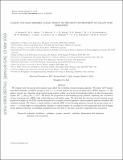Files in this item
Galaxy and Mass Assembly (GAMA) : Impact of the Group Environment on Galaxy Star Formation
Item metadata
| dc.contributor.author | Barsanti, S. | |
| dc.contributor.author | Owers, M. S. | |
| dc.contributor.author | Brough, S. | |
| dc.contributor.author | Davies, L. J. M. | |
| dc.contributor.author | Driver, S. P. | |
| dc.contributor.author | Gunawardhana, M. L. P. | |
| dc.contributor.author | Holwerda, B. W. | |
| dc.contributor.author | Liske, J. | |
| dc.contributor.author | Loveday, J. | |
| dc.contributor.author | Pimbblet, K. A. | |
| dc.contributor.author | Robotham, A. S. G. | |
| dc.contributor.author | Taylor, E. N. | |
| dc.date.accessioned | 2018-04-30T16:30:07Z | |
| dc.date.available | 2018-04-30T16:30:07Z | |
| dc.date.issued | 2018-04-16 | |
| dc.identifier | 252963286 | |
| dc.identifier | 9dc391aa-f47b-4df4-ba31-b37b0843f2ae | |
| dc.identifier | 000430190000009 | |
| dc.identifier | 85045549212 | |
| dc.identifier | 000430190000009 | |
| dc.identifier.citation | Barsanti , S , Owers , M S , Brough , S , Davies , L J M , Driver , S P , Gunawardhana , M L P , Holwerda , B W , Liske , J , Loveday , J , Pimbblet , K A , Robotham , A S G & Taylor , E N 2018 , ' Galaxy and Mass Assembly (GAMA) : Impact of the Group Environment on Galaxy Star Formation ' , Astrophysical Journal , vol. 857 , no. 1 , 71 . https://doi.org/10.3847/1538-4357/aab61a | en |
| dc.identifier.issn | 0004-637X | |
| dc.identifier.uri | https://hdl.handle.net/10023/13265 | |
| dc.description | MSO acknowledges the funding support from the Australian Research Council through a Future Fellowship (FT140100255). SB acknowledges funding support from the Australian Research Council through a Future Fellowship (FT140101166). | en |
| dc.description.abstract | We explore how the group environment may affect the evolution of star-forming galaxies. We select 1197 Galaxy And Mass Assembly groups at 0.05 ≤ z ≤ 0.2 and analyze the projected phase space (PPS) diagram, i.e., the galaxy velocity as a function of projected group-centric radius, as a local environmental metric in the low-mass halo regime 1012 ≤ (M 200/M ⊙) < 1014. We study the properties of star-forming group galaxies, exploring the correlation of star formation rate (SFR) with radial distance and stellar mass. We find that the fraction of star-forming group members is higher in the PPS regions dominated by recently accreted galaxies, whereas passive galaxies dominate the virialized regions. We observe a small decline in specific SFR of star-forming galaxies toward the group center by a factor ~1.2 with respect to field galaxies. Similar to cluster studies, we conclude for low-mass halos that star-forming group galaxies represent an infalling population from the field to the halo and show suppressed star formation. | |
| dc.format.extent | 18 | |
| dc.format.extent | 3353512 | |
| dc.language.iso | eng | |
| dc.relation.ispartof | Astrophysical Journal | en |
| dc.subject | Galaxies: evolution | en |
| dc.subject | Galaxies: groups: general | en |
| dc.subject | Galaxies: kinematics and dynamics | en |
| dc.subject | Galaxies: star formation | en |
| dc.subject | QB Astronomy | en |
| dc.subject | QC Physics | en |
| dc.subject | 3rd-DAS | en |
| dc.subject.lcc | QB | en |
| dc.subject.lcc | QC | en |
| dc.title | Galaxy and Mass Assembly (GAMA) : Impact of the Group Environment on Galaxy Star Formation | en |
| dc.type | Journal article | en |
| dc.contributor.institution | University of St Andrews. School of Physics and Astronomy | en |
| dc.identifier.doi | 10.3847/1538-4357/aab61a | |
| dc.description.status | Peer reviewed | en |
| dc.identifier.url | https://arxiv.org/abs/1803.05076 | en |
This item appears in the following Collection(s)
Items in the St Andrews Research Repository are protected by copyright, with all rights reserved, unless otherwise indicated.

